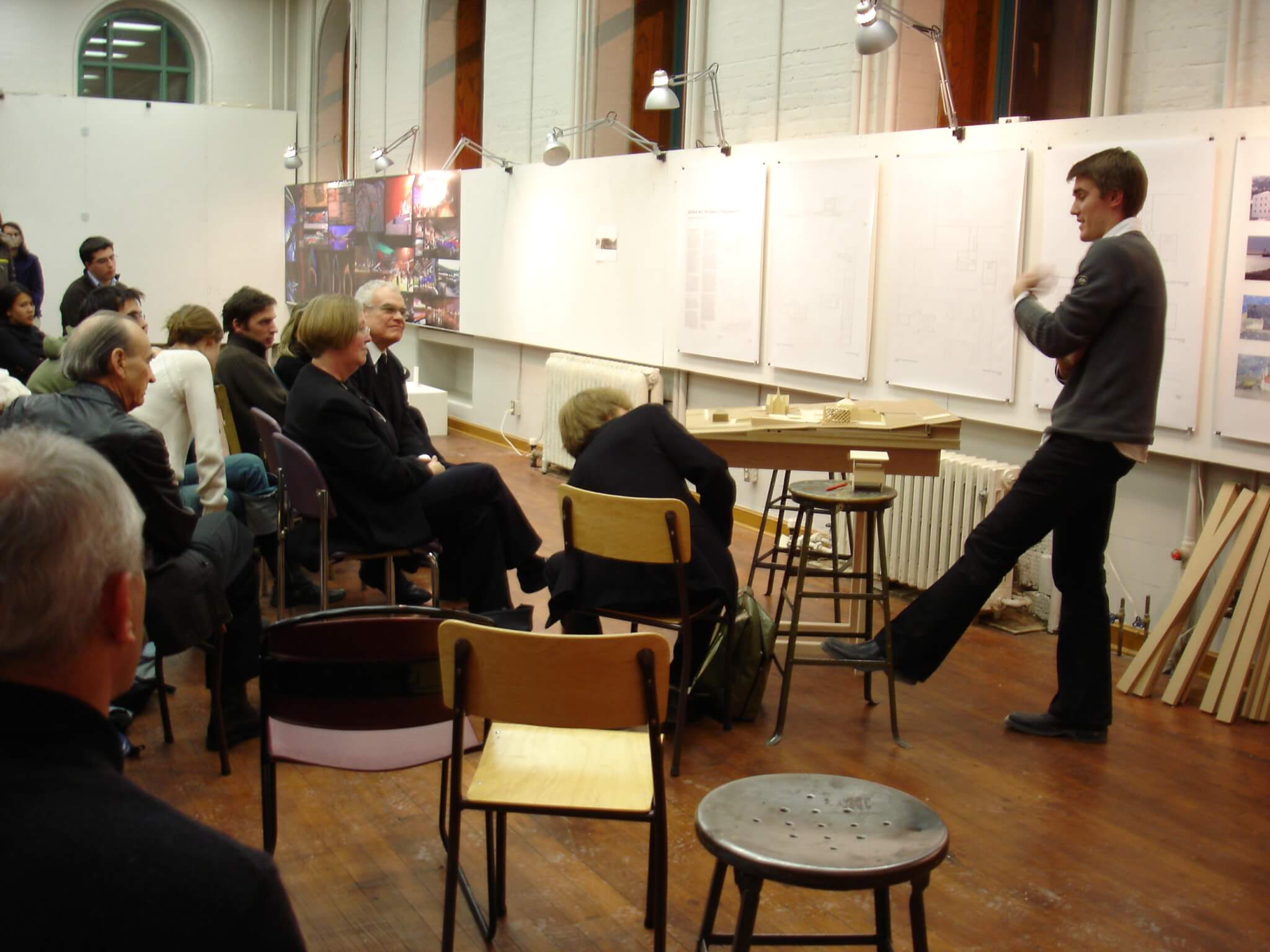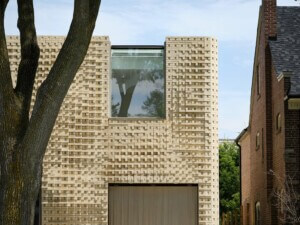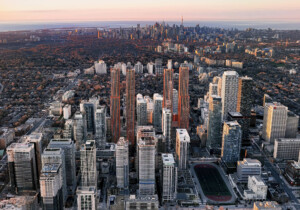My first encounter with George Baird was at my final MArch thesis review in December 2005 at the McGill University School of Architecture. My project to redesign the village center of Ste-Famille on Québec’s Île d’Orléans was inspired by Hannah Arendt’s concept of the “space of appearance.” I was seeking to avoid caricatural tropes of the historical village in favor of a more abstract yet meaningful form of public realm. While Baird, then dean of the University of Toronto’s Faculty of Architecture, was a regular guest at McGill, his presence of my jury that day was motivated by his own longstanding engagement with Arendt and the concept of public space. Although the hour-long review passed in somewhat of a blur, I vividly remember Baird’s comments, just as I remember most of our conversations since. He had visited l’Île D’Orléans on a bicycling tour of Québec decades earlier, so knew intimately the form and spirit of the place I could only glimpse through old photographs. Troubled by any sense of architecture as an instantiation of ethnic identity or “authentic” culture, he instead argued for careful reflection, tolerance, and pluralism.

Baird, who died on October 17 at the age of 84, studied architecture at the University of Toronto and University College London. Baird then taught at the University of Toronto and the Harvard Graduate School of Design and founded the office that became Baird Sampson Neuert Architects. Baird’s teaching and practice helped foster several generations of Canada’s leading architects, from Bruce Kuwabara (KPMB Architects) to Nima Javidi (JA Architecture Studio). Among his many contributions to Toronto was his consultancy role for the mixed-income neighborhood of St. Lawrence, built to replace a decaying industrial area. Thanks to Baird, today it is carefully integrated with its surrounding urban fabric. It is centered around a tree-lined linear park created in place of unused railway tracks. This vibrant space has many uses and users, including a schoolyard. As the Canadian architectural critic Alex Bozikovic explained in his obituary of Baird, the park “is the area’s space of appearance, a place for personal and political encounters.”
Other major works include several highly influential studies of Toronto’s urban form: onbuildingdowntown (1974), Built-Form Analysis (1975), and Vacant Lots in Toronto (1978). Allied with a reform-minded city council and a young generation of architects and planners, Baird challenged prevailing modernist orthodoxy and helped develop a more contextual and typological approach to urban design. As such, he belongs to generation of leaders in Canadian architecture, including CCA founder Phyllis Lambert and Toronto mayors John Crombie and David Sewell, who fought for closer engagement with the city as a living artifact imbued with historical memory. This desire for dialogue with the world as it is found can be seen in Baird’s entry in the 1980 Edmonton City Hall competition, which was disqualified for preserving the previous city hall as part a new ensemble.
Having first touched upon Arendt’s philosophy in Meaning in Architecture (a volume co-edited with Charles Jencks) in 1969, Baird deepened his engagement in The Space of Appearance (1995) and Public Space (1999). While other theorists such as Kenneth Frampton focused upon Arendt’s distinction between (biologically necessary) labor and (constructive) work, it was the third element in her triad which attracted Baird’s attention. Arendt’s concept of action, of words and deeds, revolves around the freedom to begin anew and initiate that which is unexpected and revolutionary. It can only occur in public, where an actor is surrounded by other distinct individuals. While the political “space of appearance” in which action occurred—think of the ancient Greek concept of the polis or the Roman forum—began with action and speech, what mattered for Baird was that Arendt understood it to be tangible, material. As Hans Teerds recounts in an essay on Baird’s engagement with Arendt, written for Roberto Damiani’s The Architect and the Public: On George Baird’s Contribution to Architecture, public space for Baird needs plurality, mobility, and history; it is “rough space,” where one is vulnerable.
In Public Space (2011), Baird reconciled Arendt’s notion of active public space and Walter Benjamin’s claim that architecture was perceived in a mode of distraction by constructing a continuum between the two, which he illustrated using a selection of street photographs. Images by Robert Frank, Nikki S. Lee, and others “bracket a spectrum of social praxes that exemplify publicness in our time.” Between the everyday habits and customs captured by Henri Cartier-Bresson and Stuart Franklin’s photograph of the “tank man” in Beijing’s Tiananmen Square, we move from everyday human behaviors to moments when both human life and the future of the world—Arendt clearly distinguished between the two—seem to be at stake.
My final conversation with Baird happened this summer in the company of his wife Elizabeth (herself a renowned culinary journalist) at the Canadian Centre for Architecture in Montreal. I was then preparing to bring a group of Daniels Faculty students for a summer course in Berlin. George shared his memories of that city, and his thoughts on why he preferred Hans Scharoun’s Philharmonie to Frank Gehry’s Disney Concert Hall in Los Angeles. While both shared an evident formal sympathy, he distinguished between them on phenomenological grounds. The circulation and seating at Disney seemed to carelessly divide the spectators, yielding an “experiential disappointment,” as he described it in his essay “On the Phenomenology of Spatial Sequences.” The carefully choreographed sense of spatial interconnectedness between the lobbies, mezzanines, and terraced seating in Scharoun’s masterpiece, on the other hand, enhance “the capacity of the Berlin Hall to perform as a social condenser.” While the use of the term “social condenser” may be slightly hyperbolic given its ideological associations, Baird’s analysis of the Philharmonie confirms his belief that one of architecture’s greatest powers lies in orchestrating public appearance.
Baird often remarked that one of the pleasures of a career in architecture was having knowledgeable colleagues “to help one explore the architectural sights” of places around the world, as he wrote in the epilogue to Damiani’s collection of writings. Baird himself was the ultimate guide to Toronto, and his annual graduate seminar at the Daniels Faculty taught students to appreciate the city’s urban form. He delighted in bringing visitors to the Sharon Temple, a three-tiered, square-plan building of near-perfect proportions. Built by the Children of Peace, a Quaker sect, between 1825 and 1831, the temple is located well north of the city within a campus of buildings. The delicate wood construction makes clear the contingency of efforts needed to instantiate social ideals in the material world. As a work of human artifice imbued with higher meaning, it offers an apt summary of Baird’s engagement with the world.
Peter Sealy is an architectural historian and assistant professor at the University of Toronto.











